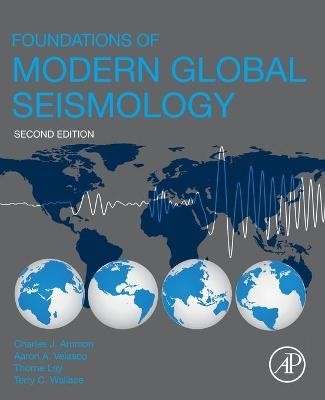
Foundations of Modern Global Seismology
Academic Press Inc (Verlag)
9780128156797 (ISBN)
Charles Ammon is a Professor of Geoscience at Penn State. His research interests include broadband imaging large earthquake rupture processes, precise location of earthquakes in remote oceanic and continental regions, 3D imaging of continental lithosphere using seismic waveforms, surface-wave dispersion, and surface gravity observations. His research has been supported by the National Science Foundation, the US Geological Survey, The Air Force Research Laboratory and the Defense Threat Reduction Agency. Ammon has taught seismology to introductory non-science students, advanced geoscience undergraduates and geophysics graduate students since 1994. He has served the research community as a member and chair of the Global Seismographic Network Standing Committee, and the vice chair of the Board of Directors for the Incorporated Research Institutions for Seismology. Dr. Aaron A. Velasco is Professor of Geological Sciences at the University of Texas at El Paso. His current research interests have spanned a variety of subjects in seismology, including investigations of dynamic triggering of earthquakes, determining 3-D Earth structure from analysis of multiple data sets, deploying seismic sensors for studying aftershocks, studying geothermal prospects, and he has a particular interest in promoting opportunities for minority students in science. He has worked in a variety of positions in the private sector (Science Applications International Corporation), a federal research laboratory (Los Alamos National Laboratory), and currently for a university (University of Texas at El Paso). Besides his professor position, he also serves as State Seismologist for Texas for the Texas Railroad Commission. As a Professor at U.C. Santa Cruz and Director of the Centre for the Study of Imaging and Dynamics of the Earth, Thorne Lay's primary research interests involve analysis of seismic waves to interrogate the deep structure of the Earth's interior and to study the physics of earthquake faulting. In the realm of deep Earth structure, the focus is on imaging structures associated with internal dynamics of the mantle, particularly the core-mantle boundary region and the vicinity of subducting lithosphere. Studies of the core-mantle boundary have revealed a complex seismic structure believed to involve a thermal and chemical boundary layer at this, the largest internal compositional contrast within the planet. One of the major questions about subducting lithosphere that is being addressed is the depth extent to which the subducting material penetrates, which is closely linked to the debate about layered mantle versus whole mantle convection. Other Earth structure interests include the lateral variations of lithospheric structure, which are studied using body waves and surface waves, and the nature of regional waves propagating in the crust. As Principal Associate Director for Global Security, Wallace leads Laboratory programs with a focus on applying scientific and engineering capabilities to address national and global security threats, in particular, nuclear threats. Wallace is also the Senior Intelligence Executive at LANL. Wallace served as Principal Associate Director for Science, Technology, and Engineering from 2006 to 2011 and as Associate Director of Strategic Research from 2005 to 2006. In those positions, Wallace integrated the expertise from all basic science programs and five expansive science and engineering organizations to support LANL’s nuclear-weapons, threat-reduction, and national-security missions.
Part I: Earthquake Basics1. Introduction2. Seismotectonics3. Seismometry and Earth Motions4 Seismogram Interpretation and Processing5. Earthquake Location and Geophysical Inverse Problems6. Earthquake Size and Descriptive Earthquake Statistics7. Earthquake Recurrence and Prediction8. Tsunamis9. Earths' Interior Part 2: Theory and Application10. Foundations of Elasticity and Fracture11. Elastic Waves12. Body Waves and Ray Theory - Travel Times13. Body Waves and Ray Theory - Amplitudes14. Surface Waves15. Surface Waves on a Sphere and Free Oscillations16. Ground Deformation and Wave Excitation17. Seismic Point Source - Models18. Finite Kinematic Earthquake Models19. Seismic Waveform Modeling20. Imaging the Earth with Travel Times21. Imaging the Earth Using Seismic Waveforms
| Erscheinungsdatum | 27.10.2020 |
|---|---|
| Verlagsort | San Diego |
| Sprache | englisch |
| Maße | 191 x 235 mm |
| Gewicht | 1200 g |
| Themenwelt | Naturwissenschaften ► Geowissenschaften ► Geologie |
| Naturwissenschaften ► Geowissenschaften ► Geophysik | |
| ISBN-13 | 9780128156797 / 9780128156797 |
| Zustand | Neuware |
| Informationen gemäß Produktsicherheitsverordnung (GPSR) | |
| Haben Sie eine Frage zum Produkt? |
aus dem Bereich


